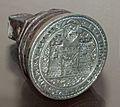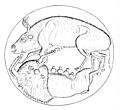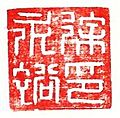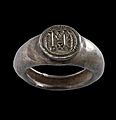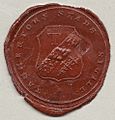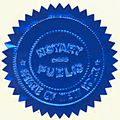Seal (device) facts for kids
A seal is a special mark or design pressed onto something important, like a letter or document. It's often made from wax and shows that the item is real and official. The word "seal" can also mean the tool used to make this mark, like a metal stamp or a ring.
The word "seal" comes from the Latin word "sigillum." Learning about seals is called Sigillography.
Contents
What Seals Do
Seals are used on important papers to prove they are real. They show that the document truly came from the person who signed it. This is called "authenticating" a document.
A seal could be placed right on the letter or on the envelope where it was closed. To make a seal, someone would pour melted wax onto the paper. Then, they would press a special ring or metal stamp, called a "matrix," into the wax. This stamp had their unique official mark.
This method made sure no one could open the letter and then close it again. If someone tried to open it, the wax seal would break. Today, most governments still use seals on very important documents. However, regular letters usually don't have seals anymore.
Sometimes, instead of wax, people used other materials. These included lead, pewter, or even ivory. Every seal is unique. This means that important people, like kings, had their own special stamp.
History of Seals
Seals have been used for a very long time, even in ancient civilizations.
Seals in Ancient Times
- In ancient Mesopotamia, seals were carved onto cylinders. These cylinders could be rolled over clay to create a repeating pattern.
- Signet-rings belonging to kings have been found from Ancient Egypt.
- Other old seals have been discovered in places like Saudi Arabia, Ancient Greece, and Ancient Rome.
Seals After the Roman Empire
After the Roman Empire ended around 476 AD, seals were not used as much for a while.
- The Popes, who are leaders of the Catholic Church, used seals made of lead.
- Charlemagne, a famous emperor who died in 814 AD, had a special seal.
- In England, every king from Edward the Confessor onwards had their own "seal of majesty." This was a grand seal showing their power.
Seals in East Asia
Seals in East Asia later helped develop block printing. Seals from China have been found that date back to the 5th century BC.
Signet Rings and Traditions
Wearing signet rings is a very old tradition. The word "signet" comes from the Latin word "signum," meaning "sign."
- Many noble families in Europe and other cultures wore signet rings.
- In Latin America, it's also a tradition for descendants of old aristocratic families to wear them.
Signet rings were often worn on the little finger of either the right or left hand. However, customs varied by country. For example, in the United Kingdom, they are usually worn on the little finger of the left hand. These rings are often made of gold. The seal on the ring is usually worn facing outwards. This way, the wearer could make a seal without taking the ring off.
A similar tradition existed with blacksmiths. They used a "touchmark," which was a stamp pressed onto hot metal. This mark showed who made the item. When a blacksmith died, their touchmark was destroyed.
The study of seals, called sigillography, is very helpful. It helps people learn about:
- Genealogy (family history)
- Political history
- Art history
Modern science can figure out the age of a seal very accurately. This helps historians date old documents or artworks.
Metaphorical Uses of "Seal"
The word "seal" is often used in other ways, like a metaphor:
- To "set one’s seal" or give one’s "seal of approval" means to officially agree with something. It's like saying "I approve!"
- Because seals close things officially, the word "seal" can mean to make a promise. For example, the promise made by two people at their marriage is a "seal."
- To "seal" can mean to decide or settle something. For example, to "seal someone’s fate" means to decide what will happen to them. Or, to "seal a business agreement" means to finalize a deal.
- To "seal" can also mean to close something for a long time. If an area is "sealed off," it means it's closed so no one can enter.
- A secret record is often called "sealed."
- Encyclopædia Britannica 1973 edition
Images for kids
-
A Mesopotamian limestone cylinder seal and the mark it makes. This one shows worship of Shamash.
-
A demonstration of how a standard seal (Chinese: 公章) is used by organizations in China.
-
An Equestrian seal of Gilbert de Clare, an earl, from around 1218–1230.
-
The wax seal of Tampere from 1839.
-
An embossed notary seal, which was once valid in the State of New York.
-
Two-sided seals from Inchaffray Abbey in Scotland, from the late 13th century. These are now in the British Museum.
-
A professional engineer's seal (which is actually a rubber stamp) from Saskatchewan, Canada.
-
An Armigerous signet ring with the family crest of the Baronnet family.
-
A golden ring with the hieroglyphic name of Tutankhamun from the Musée du Louvre.
See also
 In Spanish: Sello (cuño) para niños
In Spanish: Sello (cuño) para niños



